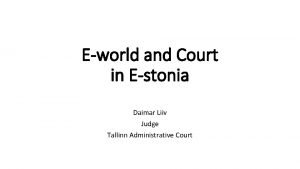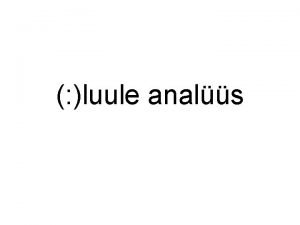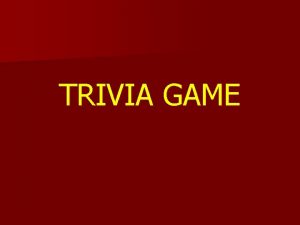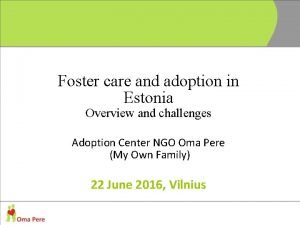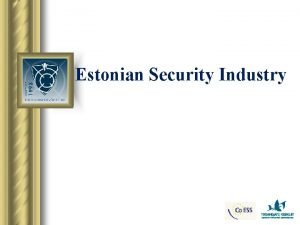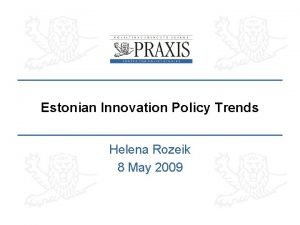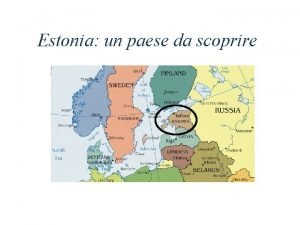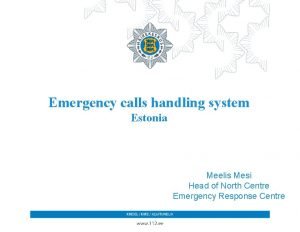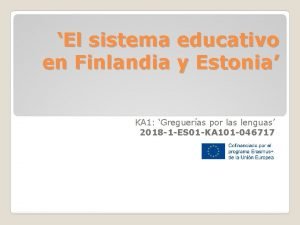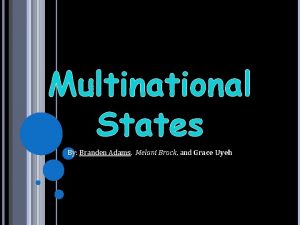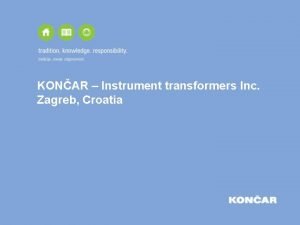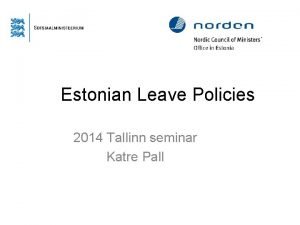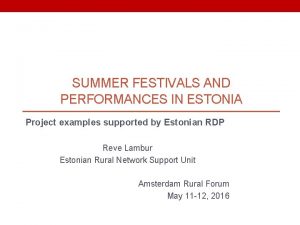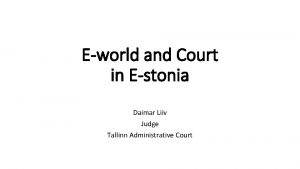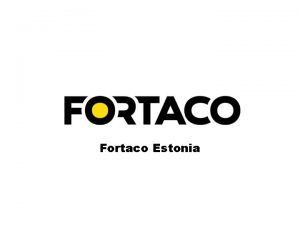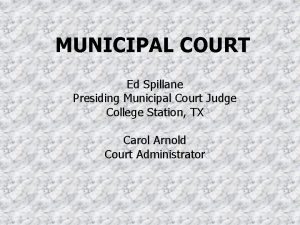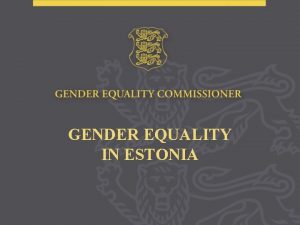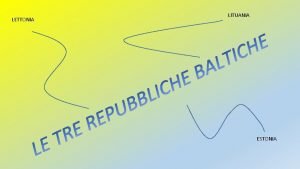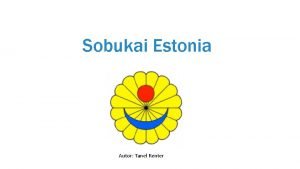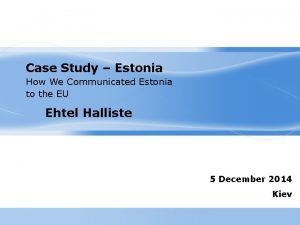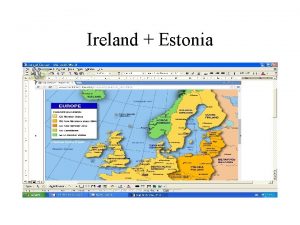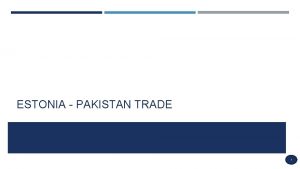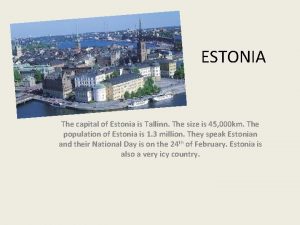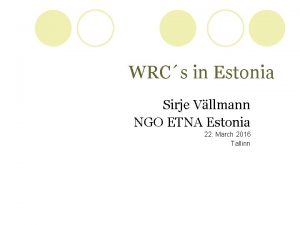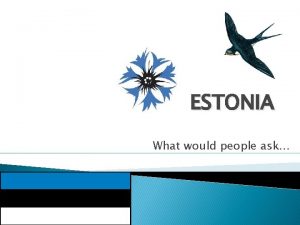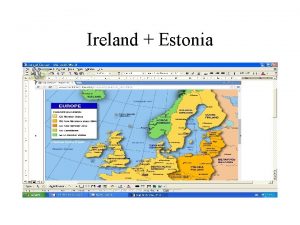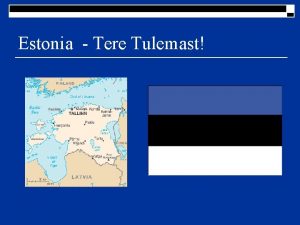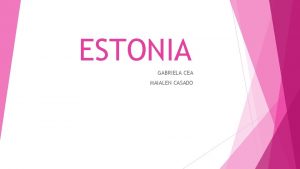Eworld and Court in Estonia Daimar Liiv Judge




















- Slides: 20

E-world and Court in E-stonia Daimar Liiv Judge Tallinn Administrative Court

E-stonia • Estonians were first in USSR to start to introduce computers into education system. • Nõo Secondary School received in 1965(!!!) computercenter with Tartu University electronic computer „Ural-1“. It was the first school computing center in the entire USSR and computer teaching was started in school.

E-stonia • Estonians were first in the USSR in 1980 ties to start use computers and xerox machines in private organisations which finally destroyed information and printing monopoly of the communist state as well this state • There was little number of real executive power institutions in Estonia and therefore no well-established paper bureaucracy and large paper based information bases in public administration. • Initial foreign aid in the beginning of 1990 for the public administration consisted often of computers. It was decentralized and lot of diferent equipment appeared from the beginning in state sector which was mainly used for word-processing and for creating initial databases. • Estonians were eager to start use of computers – we became „westeners“ through it! • Banking system was created from zero and with computer-based infomanagment.

Estonia is a E-state Estonia has by far the most highly-developed national ID card system in the world. • Much more than simply a legal picture ID, the mandatory national card serves as the digital access card for all of Estonia’s secure e-services. • The chip on the card carries embedded files which, using 2048 -bit public key encryption, enable it to be used as definitive proof of ID in an electronic environment. • There are more than 1. 2 million active e-ID cards in Estonia. That’s nearly 94% of Estonia's 1. 3 million residents Here are some examples of how the ID Card is regularly used in Estonia: • • As a national ID card for legal travel within the EU for Estonian citizens As the national health insurance card As proof of identification when logging into bank accounts from a home computer As a pre-paid public transport ticket in Tallinn and Tartu For digital signatures For i-voting For accessing government databases to check one’s medical records, file taxes, etc. For picking up e-Prescriptions

Just some cool services (1) e-Business Register • Estonia’s e-Business Register is an advanced and secure tool that allows entrepreneurs to register their new business online in just minutes (18 minutes), without having to go to a notary or some other official. e-Cabinet • The Information System of Government Sessions, better known as e-Cabinet, is a powerful tool that the Estonian government uses to streamline its decision-making process. • The duration of typical Estonian cabinet meetings since using e-Cabinet: 30 -90 minutes • It lets ministers prepare for cabinet meetings, conduct them and review minutes, entirely without paper. e-Law • The e-Law system is the Estonian Ministry of Justice’s online database for draft legislation. • More properly called the Electronic Coordination System for Draft Legislation, it allows the public to access every piece of draft law that has been submitted since February 2003. • Readers can see who submitted the legislation, its status, and the changes made to it as it passed through the parliamentary process. i-Voting • Internet voting, or ‘i-voting’, is a system that allows voters to cast their ballots from any internet-connected computer, anywhere in the world. • In the 2015 Parliamentary Elections, Internet voting accounted for 30, 5 percent of the votes cast. Estonians worldwide cast their votes from 116 different countries.

Just some cool services (2) e-Tax • E-Tax is the electronic tax filing system set up by the Estonian Tax and Customs Board and it was introduced publicly in 2000. • Using a secure ID, a taxpayer logs onto the system, reviews their data in pre-filled forms, makes any necessary changes, and approves the document with a digital signature. The process typically takes three to five minutes. From 2015 one-click tax returns are also available, all known data is displayed to the citizen together with the calculated result, then all they have to do is click on the confirmation button; all this takes less than a minute. • Each year around, 95 percent of tax declarations in Estonia are filed electronically. State e-Services Portal • The State Portal, eesti. ee, is a website that acts as a one-stop-shop for the hundreds of e-services offered by various government institutions introduced in 2003. It is single point of contact – 99% of all state services • Rather than having to hunt for a particular service on the Internet, a user can simply head to this gateway site and find the appropriate link. Electronic Land Register • The e-Land Register is a one-of-a-kind web application that contains information of all ownership relationship and limited real rights of real estates and land parcels. Currently, there are 1. 003. 946 immovables in the Land Register. • A critical tool for the real-estate market, it provides total transparency; listing the registered owner of each property holding, showing the property boundaries and providing other information that potential buyers would need to know. • Paired with a geographical information system (GIS), the electronic land register delivers real-time geographical data through the X-road, enabling advanced map-based visualizations that power many of the location-based services in Estonia.

X-road • X-Road is the backbone of e-Estonia. It’s the invisible yet crucial environment that allows the nation’s various e-services databases, both in the public and private sector, to link up and operate in harmony. • X-Road is the all-important connection between these databases, the tool that allows them to work together for maximum impact. All of the Estonian e-solutions that use multiple databases use X-Road. All outgoing data from the X-road is digitally signed and encrypted. All incoming data is authenticated and logged. • Originally X-Road was a system used for making queries to the different databases. Now it has developed into a tool that can also write to multiple databases, transmit large data sets and perform searches across several databases. • In 2013 over 287 million queries were done over X-road. • Over 170 databases offer their services over X-Road in Estonia. • Over 2, 000 services are used over X-Road in Estonia. • Over 900 organisations use X-Road daily in Estonia. • More than 50% of the inhabitants of Estonia use X-Road through the information portal eesti. ee.

E-Legislation • 1996 rather originaal Databases Act was passed by the Parliament (substantially amended in 2004 and introduced tot he Public Information Act in 2008) as well as Data Protecion Law – mainly on formation of public databases • 2000 - Public Information Act (was modernised in 2007) https: //www. riigiteataja. ee/en/eli/518012016001/consolide • Regulation of the Government of the Republic on the Administration System of the State Information System (2001). • Regulation of the Government of the Republic on the Data Exchange Layer of Information Systems (2008). Population Register Act. • 2000 – Digital Signatures Act https: //www. riigiteataja. ee/en/eli/508072014007/consolide

Computerisation of courts. Infosystem • Started chaotically in 1992, turning point was creation in 1996 of the Court Decision Register (centralized)

2006 Court Information System (v 1. 0)

2014 Court Information System – KIS 2 New system based on E-file system 4 800 000 proceedings Every minute 400 -500 searches Response time 0, 7 sec 4 TB and 20 000 files, 1, 1 TB database files

How did we get there with E-file? • Started in 2006 • Launched in September 2009 with criminal and misdemeanor proceedings • Launched the Criminal Records in 2012 • Launched the civil and administrative proceedings in 2014 • As of 2017 no paper file, only digital file? Should provide for hyperlinks between documents and easier search options from the documents of the case file

How it works today

Problems • Initially too many interruptions as system was little tested • Training was almost absent • Sometimes slow • Search function needs development • Individualization of interface (working environment) needs to be trained and possibilities explained • Two screens are needed for really effective use!

Good points • You almost don`t need paper file • Everything is in one place • Judge does only writing and search for it – all ohter actions are done by secretary • Accessible over the Internet – you can work everywhere! • Almost all exchange of documents is rapid and parties are in most cases easily accessible • Back-up service works!

Summary – what we have today Integrated IT systems • IT systems of courts, police, prosecutors´ office, company registries etc are connected via e-file system • Data between different systems is exchanged automatically • Court judgments are published in the National Gazette after entry into force Audio and video • In criminal cases audio recording is compulsory – written minutes done after the session • In administrative cases court sessions are audio recorded with Liberty Court Player – no written minutes afterwards • Videoconference is used in court cases involving prisoners and other detainees • Also for hearing witnesses abroad • In criminal cases only in procedural matters (conditional release on parole etc)

Summary – what we have today IT in court administration • Exact, up-to-date statistics in real time to monitor case load, judges´ performance • Easy detection of delays in court proceedings • Automatic case allocation, taking into account the complexity and volume of cases in order to guarantee equal allocation of workload between judges • CIS in integrated with calendars of the judges and staff and court room • Bookkeeping and monetary issues in one center

Summary – what we have today Legislation supports use of IT in courts and finally Almost all clients and all judges and our staff have a high e-culture!!

What Estonian judges are still dreaming of… • Better screens and more powerful computers (Of course!) • Excellent and quick search machine • Voice recognition system • and finally • AI module for every judge for a fully compurerized decisionwriting

Thank you for your attention! Daimar Liiv Judge Tallinn Administrative Court Pärnu mnt 7, Tallinn, 15082 Estonia + 372 6282704 daimar. liiv@kohus. ee Skype: daimar 1
 Ero liivik
Ero liivik Daimar liiv
Daimar liiv Luule analüüs
Luule analüüs Tanel rand
Tanel rand Is there a basketball court above the supreme court
Is there a basketball court above the supreme court Estonia innovation
Estonia innovation Estonia innovation
Estonia innovation Estonia adoption
Estonia adoption Estonia innovation
Estonia innovation Estonia flora e fauna
Estonia flora e fauna 340122
340122 Estonia innovation
Estonia innovation Idrografia estonia
Idrografia estonia Meelis mesi
Meelis mesi Sistema educativo de estonia
Sistema educativo de estonia Acerage salary
Acerage salary Naufragio estonia
Naufragio estonia Branden adams
Branden adams Estonia main exports
Estonia main exports Katre pall
Katre pall Estonia lantern festival
Estonia lantern festival

